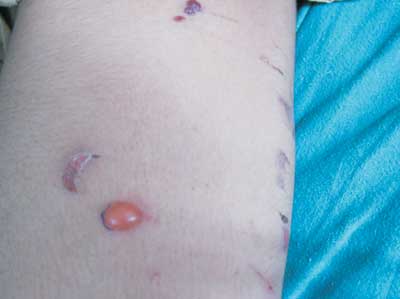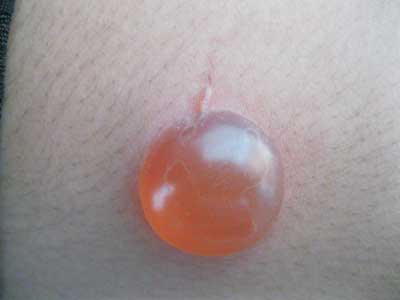|
|
|
Indian Pediatr 2013;50: 897-898 |
 |
Bullous Dermatitis Artefacta
|
|
D Pandhi and A Singal
Department of Dermatology and STD, University College
of Medical Sciences and Guru Tegh Bahadur Hospital,
University of Delhi, Delhi, India.
Email:
deepikapandhi@rediffmail.com
|
A 14-year-old girl presented with bullous lesions over both
thighs for 3 weeks. There were variably sized, discrete and
coalescent, tense bullae surrounded by irregular erythema (Figs.
1,2) and linear and curvilinear erosions at various
stages of healing. She provided inconsistent history of
evolution and had been treated with systemic steroids
without improvement. Her skin biopsy showed necrosis of
epidermis and direct immunofluorescence was negative for C3,
IgG, IgA, IgM. A diagnosis of bullous dermatitis artefacta
was made and psychiatric evaluation was sought. She was
given a diagnosis of borderline personality disorder with
poor impulse control and admitted to inducing lesions with
chemicals and pinching. She was kept under observation and
treated with Olanzapine and topical antibiotics with
counseling which led to healing of lesions.
 |
|
Fig. 1 Tense, hemorrhagic
bullae, bizarre shaped, crescent shaped and linear
superficial erosions over the thigh.
|
| |
 |
|
Fig. 2 A tense blister with
linear erythema and vesiculation indicating
streaking.
|
Dermatitis artefacta is a disorder of
self-injurious behavior for psychological gain. There is
predominant involvement of adolescent females. Bullous
dermatitis artefacta can be differentiated from
immunobullous diseases by the erratic history, overnight
onset and presence of bizarre, linear or geometric lesions
and superficial erosions. The lesions can be induced by
picking, pinching, burning, scalding with chemicals,
suctioning or cryoinjury. The management should include
avoidance of confrontation, behavioral therapy, and
appropriate pharmaco therapy. A high index of suspicion can
ensure timely psychiatric intervention.
|
|
|
 |
|

